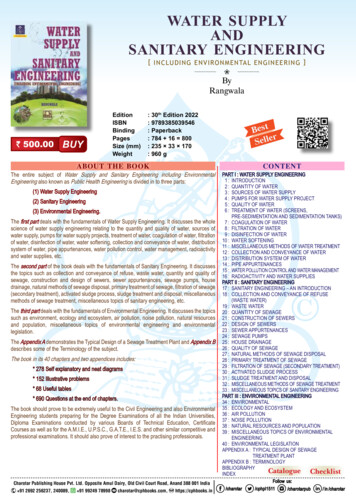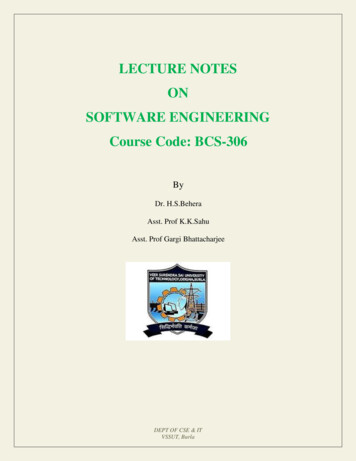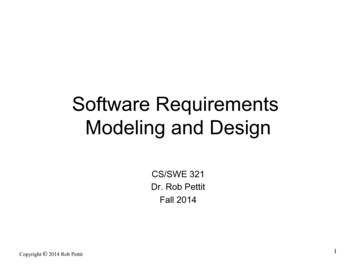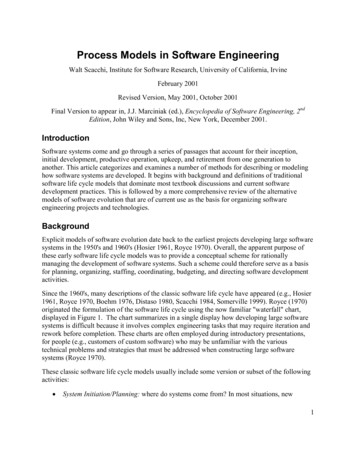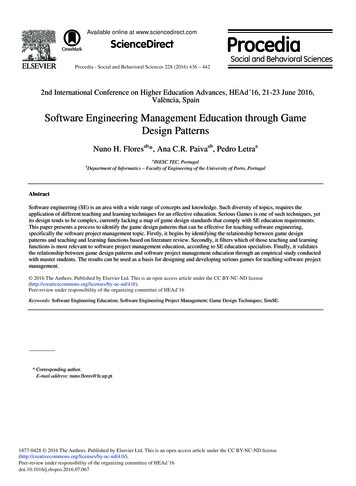
Transcription
Available online at www.sciencedirect.comScienceDirectProcedia - Social and Behavioral Sciences 228 (2016) 436 – 4422nd International Conference on Higher Education Advances, HEAd 16, 21-23 June 2016,València, SpainSoftware Engineering Management Education through GameDesign PatternsNuno H. Floresab*, Ana C.R. Paivaab, Pedro LetraaaINESC TEC, PortugalDepartment of Informatics – Faculty of Engineering of the University of Porto, PortugalbAbstractSoftware engineering (SE) is an area with a wide range of concepts and knowledge. Such diversity of topics, requires theapplication of different teaching and learning techniques for an effective education. Serious Games is one of such techniques, yetits design tends to be complex, currently lacking a map of game design standards that comply with SE education requirements.This paper presents a process to identify the game design patterns that can be effective for teaching software engineering,specifically the software project management topic. Firstly, it begins by identifying the relationship between game designpatterns and teaching and learning functions based on literature review. Secondly, it filters which of those teaching and learningfunctions is most relevant to software project management education, according to SE education specialists. Finally, it validatesthe relationship between game design patterns and software project management education through an empirical study conductedwith master students. The results can be used as a basis for designing and developing serious games for teaching software projectmanagement. by byElsevierLtd.Ltd.This is an open access article under the CC BY-NC-ND license d/4.0/).Peer-review under responsibility of the organizing committee of HEAd 16.Peer-review under responsibility of the organizing committee of HEAd 16Keywords: Software Engineering Education; Software Engineering Project Management; Game Design Techniques; SimSE.* Corresponding author.E-mail address: nuno.flores@fe.up.pt1877-0428 2016 The Authors. Published by Elsevier Ltd. This is an open access article under the CC BY-NC-ND nd/4.0/).Peer-review under responsibility of the organizing committee of HEAd 16doi:10.1016/j.sbspro.2016.07.067
Nuno H. Flores et al. / Procedia - Social and Behavioral Sciences 228 (2016) 436 – 4424371. IntroductionSoftware Engineering (SE), as a domain area, encompasses a wide and dense range of concepts and knowledge.The SWEBOK (Swebok, 2014), an organizational structure proposed by the IEEE, promotes a common andconsistent understanding of those concepts, and how they relate to other areas. Effectively acquiring such diverseknowledge relies on a considerable amount of learning and teaching techniques (Claypool, 2005)(Schilling,2012)(Yu 2014). One such technique is the use of serious games, but the inherent complexity of designing suchgames prevents its use on a large scale (Westera, 2008). Furthermore, the requirements for an effective andsuccessful game do not always match the requirements for a proper SE learning task. This paper describes theapplied process to elicit the learning and teaching functions (Grosser, 2007) relevant for SE education, focused on itsmanagement sub-area (according to the Swebok), as well as the identification of game design patterns (Bjork, 2004)that cover those specific functions. The resulting set should promote a more focused and effective design of gamebased techniques for teaching SE topics. Validation of results relied on empirical methods, namely surveys andquestionnaires to SE teachers and a case study performed with students, using a serious game designed for SEeducation (Navarro, 2006).The results presented in this paper come from a second iteration of the presented process, performed to confirmand consolidate the preliminary results obtained in a previous iteration (Letra, 2015). This second iteration allowedthe process to be refined in order to eliminate some bias thus improving the results quality, and to evaluate the gameexperience individually, instead of in pairs.2. The ABC of Game-Based Software Engineering Management EducationWhen designing a game for teaching any kind of subject, the main concern should be to, not only keep the learnerin a “flow” state (Csikszentmihalyi, 1975), but to meet the cognitive needs and nurture the player’s learning. Thetheoretical statement behind the work presented in this paper can be visualized as a triangle. In one vertex there isthe cognitive aspects of learning, on another vertex, there are the game design best practices that create an effectivegaming experience and on the other vertex there is the specific knowledge domain to be taught (or learned).Combining and connecting these 3 key aspects should provide a viable framework for developing game-basededucation solutions for any specific topic. To instantiate with each of these elements, the authors surveyed theliterature in search of existing solutions.2.1. Learning and Teaching FunctionsTo cope with the cognitive aspects of learning, the authors reviewed the work of Grosser (2007). Based on thecontribution of Shuell and Muran (1994), Grosser created a list of 22 learning and teaching functions (LTFs) thatcover all the pedagogical scope. In its definition, a learning function (LF) regards the learner's point of view on howto link new information to prior knowledge, how to organize information, and how to acquire cognitive and metacognitive knowledge. A teaching function (TF) defines the teacher's goal at ensuring the learner has the properequipment (i.e., using the proper learning functions) in order to engage with the learning material in a meaningfulway. Thus, an important TF is to identify and thoroughly analyse those LFs executed by learners, assisting them inacquiring and executing those LFs. LTFs can be grouped in 5 distinct categories (Figure 1).
438Nuno H. Flores et al. / Procedia - Social and Behavioral Sciences 228 (2016) 436 – 442Fig. 1. Learning and Teaching Functions (LTFs) according to Grosser (Grosser, 2007).For instance, Prior knowledge activation, focuses on reminding students of prerequisite information or askingoneself what is already known about the topic being learned, whereas Interpreting, aims at assisting learners inconverting information from one form of representation to another. A description of each LTF can be found in(Grosser, 2007).2.2. Game Design PatternsTo design an effective game, Bjork and Holopainen (2004) developed a collection of 296 design patterns relevantto games, most specifically, design of games. Design patterns are reusable good solutions for recurring problemswithin a specific context (Alexander et al., 1977). As such, a game designer can rely on these “best practices” asbuilding blocks to guide the development of an effective game, considering its specific requirements context. Thesepatterns are divided in 11 categories (see Figure 2), regarding 4 different views on games: holistic, boundaries, timeand structure.Fig. 2. Game Design Pattern categories with number of patterns between “()” . Source: Bjork (2004)Patterns such as Role-playing (Social interaction), Randomness (Mastery and Balance), Asymmetric Information(Information, Communication and Presentation) or Rewards (Actions and Events) are just a few examples of thewhole pattern set.2.3. The ABC TriangleThe domain of knowledge focused by the presented work is SE project management. As such, the completed keyaspect triangle can be viewed in Figure 3.Fig. 3. The key aspect ABC triangle, instantiated to the presented work context.
Nuno H. Flores et al. / Procedia - Social and Behavioral Sciences 228 (2016) 436 – 442With this in mind, the main question a game designer poses when conceiving and devising an educational gamefor a specific context is: “What game design patterns to use so that the specific cognitive aspects of the specificdomain of knowledge are covered?”. In order to answer this question, all edges of the triangle must be known, thatis, LTFs and GDPs (edge A), LTFs and SEM (edge B) and GDPs and SEM (edge C) must map onto one another.Therefore, the main goal of the proposed approach is to provide evidence that these aspects relate, that is, there is amapping between the concepts, which correspond to the “edges” of the triangle (named “A”, “B”, and “C”, thus the“ABC” triangle metaphor).3. MethodologyThe applied process to define the mappings (edges) between the concepts (vertices) of the triangle proceeded asfollows:Step 1: Mapping between LTFs and GDPs – Edge AThrough literature review, the authors found that this step had already been done by Kelle et al. (2011), where amap was established between Shuel and Moran’s learning and teaching functions and Bjork and Holopainen’s gamedesign patterns. In a nutshell, they connected the LTFs to the pedagogical taxonomies of Gagne (1965), Heinich etal. (2001), Kolb (1984) and Keller (1983) as to elicit the LTF pedagogical requirements, later selecting the GDPsthat would best support there requirements.Step 2: Mapping between LTFs and SEM – Edge BIn order to identify and validate which specific LTFs are used in SEM education, a questionnaire was presentedto high education professionals. Its questions inquired which LTFs would be more relevant, concerning a specificsub-topic of SEM, namely Initiation and Scope Definition, Software Project Planning, Software Project Enactment,Review and Evaluation, Closure, SE Measurement, SE Management Tools. The expected results were a common setof LTFs, specific to SEM education.Step 3: Mapping between GDPs and SEM – Edge CTaking on the results of the previous steps, the specific LTFs (step 2) were then mapped (step 1) to GDPs, thusproviding the mapping between these and SEM knowledge. This mapping was validated through an experiment withstudents, where they played an educational (serious) game about SEM, which contained the specific game designpatterns. The expected results were based on knowledge intake and overall satisfaction on playing the game.4. Survey to software engineering management education professionalsIn order to minimize the inherent ambiguity of the LTFs and narrow down the relevant set to the present context,a survey was conducted, aimed at SE education professionals. The targeted subjects were high-education specialists,from both national and international institutions, ranging from 5 to 20 years of experience teaching SEM. Thesubjects would then answer a questionnaire where they would indicate which of the 22 LTFs would be most suitedfor effective learning of a specific sub-area of SEM.Analysing the 10 (together with the other 5, from the first iteration (Letra, 2015)) responses obtained, it wasdetermined that, for each sub-area, there was, at least, one LTF that all subjects indicated as 100% relevant toprovide effective learning. Other LTF’s were not completely agreed upon, so they were discarded. As such, andusing the mapping from LFTs to GDPs (edge A), and the results of the survey (mapping of LFTs to SEM, edge B), amapping between GDPs and SEM (edge C) can be obtained, as shown in Figure 4.439
440Nuno H. Flores et al. / Procedia - Social and Behavioral Sciences 228 (2016) 436 – 442Fig. 4. Selection of Game Design Patterns from the LTFs deemed (surveyed) relevant to SEM Education.5. SimSE Case StudyTo validate the effectiveness of the mapped game design patterns, an empirical study involving students wasconducted.The main goal was to observe the students playing an educational (serious) game about SE projectmanagement, containing the mapped GDPs (in bold, in Figure 4), while measuring learning effectiveness. Theselected game was SimSE (Navarro, 2006), a simulation game for learning about SE project management.5.1. SubjectsThe experiment subjects were 26 MSc students of the 2nd year of the Integrated Master in Informatics andComputing Engineering (MIEIC), from Faculty of Engineering of the University of Porto. The general profile of 2ndyear students had, if at all, very basic notions of SE project management, thus fitting the purpose of the experiment.Nevertheless, all students where scrutinized for their background and grades (average), being split into twohomogenous groups: Group A would undertake experiment treatment A, while Group B would undertakeexperiment treatment B.5.2. Experiment ProtocolThe student groups undertook the following experiment protocol, as depicted in Figure 5.startormpFourGoatiGroup BnGroup A!ost iue-QerP5 mins.eairnnck(BameGa15 mins.t orTuendBd)ungroialyPlameGa45 mins.owKngled20 mins.noneairirenaon )ites ceQu erienst Po (Expst iueeQA10 mins.Fig. 5. Empirical study protocol.Treatment “A” (Group A): Group A answered a pre-questionnaire for background check, watched a gametutorial (to learn how to play the game), played the SimSE game and x§afterwards answered a questionnaire(available at www.fe.up.pt/ apaiva/QuestionnaireCSE15.pdf) to evaluate the knowledge intake about SEM gainedfrom playing the game. Finally, a post-questionnaire was answered to discard possible external threats to validity.Opposite to the first iteration, this time the students played the game individually, instead of in pairs.Treatment “B” (Group B): Group B answered the same pre-questionnaire as Group A and answered theknowledge intake questionnaire. Acting as a “control” group, performing only these two steps allowed for an initialmeasurement of specific knowledge about SEM, so that these results could be compared with the same results ofGroup A, but after playing the SimSE game.
Nuno H. Flores et al. / Procedia - Social and Behavioral Sciences 228 (2016) 436 – 4424415.3. ResultsAnalysis of results from both Pre- and Post-questionnaires indicated that both the previous backgroundknowledge about SEM and external threats to validity where conveniently discarded (See Table 1.). Bothquestionnaires were designed using a 5-point Likert (1932) scale.Table 1. Pre- and Post-Questionnaires results.Comparing responses from both knowledge questionnaires (Group A and Group B) a 39,12% scoreimprovement was observed (backing the 36,54% score achieved at the first iteration), indicating that the gameactually promoted the intake of knowledge about SEM.6. ConclusionsThis paper described the process of gathering and validating a set of game design patterns relevant for SoftwareEngineering Management education (SEM), using an existing mapping technique from learning and teachingfunctions to game design patterns. Validation of the learning and teaching functions specific for SEM, wasaccomplished through surveys to SE education specialists, while an empirical study placed computer sciencestudents with low knowledge of SEM playing the game "SimSE", as to validate the identified game design patterns.The results showed a clear improvement in knowledge intake after playing the game, either individually or in pairs.These results may be used in the design and development of games for SE education in general, noting that toimprove the quality of the game, the maximum number of the identified game design patterns should be considered,covering as much learning functions as possible.AcknowledgmentsThis work is financed by the ERDF – European Regional Development Fund through the Operational Programmefor Competitiveness and Internationalisation - COMPETE 2020 Programme within project «POCI-01-0145FEDER-006961», and by National Funds through the FCT – Fundação para a Ciência e a Tecnologia (PortugueseFoundation for Science and Technology) as part of project «UID/EEA/50014/2013».ReferencesAlexander, C., Ishikawa, S. & Silverstein, M. (1977). A pattern language: Towns, Buildings, Construction. Oxford University Press, UK.Bjork, S. & Holopainen, J. (2004) Patterns in Game Design, C. River Media, Boston, MA.Claypool, K.,Claypool, M. (2005). Teaching software engineering through game design. SIGCSE Bull. 27(3), 123-127.Csikszentmihalyi, M. (1975) Play and intrinsic rewards. Journal of Humanistic Psycology, 15(3), 41-63Gagne, R. M. (1965). The Conditions of Learning, Holt, Rinehart and Winston, Austin, TX.Grosser, M. (2007). Effective teaching: linking teaching to learning functions, South African Journal of Education, 27(1), 37-52Heinich, R., Michael, M., Smaldino, S. E. & Russell, J. D. (2001) Instructional Media & Technologies for Leraning, 7th ed., Prentice-Hall, UpperSaddle River, NJ, USA.Kelle, S., Klemke, R. & Specht, M. (2011). Design patterns for learning games, Int. J. Techonology Enhanced Learning, 3(6), 555-569Keller, J. M. (1983) Motivational design of instruction. Instructional Design Theories and Models: An Overview of their Current Status, 1, 386434, Routledge, NY, USA.Kolb, D.A. (1984) Experential Learning: Experience as a Source of Learning and Development, Prentice-Hall Englewood Cliffs, NJ, USA.
442Nuno H. Flores et al. / Procedia - Social and Behavioral Sciences 228 (2016) 436 – 442Letra, P., Paiva, A. C. P., Flores, N. (2015). Game Design Techniques for Software Engineering Management Education. 18th Int. Conf.Computation Science and Engineering, Porto, Portugal.Likert, R. (1932) A technique for the measurement of attitudes. Archives of Psychology, 22, 1-55.Navarro, E. (2006). SimSE: A Software Engineering Simulation Environment. University of California, Irvine, USA.Schilling, W. W. & Sebern, M. J. (2012), Teaching Software Engineering: An Active Learning Approach. 2012 ASEE Annual Conference, SanAntonio, Texas, USA.Shuell, T. J. & Moran, K. A. (1994). Learning theories: historical overview and trends. The International Encyclopedia of Education, 2nd ed.,3340-3345, Pergamon, Oxford, UK.Swebok. (2015). Guide to software engineering body of knowledge. IEEE Computer Society. Accessed at September 2015 fromhttp://www.swebok.org.Westera, W., Nadolski, R., Hummel, H. G. K. & Wopereis, I. G. J. H. (2008). Serious Games for higher education: a framework for reducingdesign complexity. Journal of Computer Assisted Learning, 24(5), 420-432Yu L. (2014). Overcoming Challenges in Software Engineering Education: Delivering Non-Technical Knowledge and Skills (1st ed.). IGI Global,Hershey, PA, USA.
2.2. Game Design Patterns To design an effective game, Bjork and Holopainen (2004) developed a collection of 296 design patterns relevant to games, most specifically, design of games. Design patterns are reusable good solutions for recurring problems within a specific context (Alexander et al., 1977). As such, a game designer can rely on these .

